
National Geographic Kids
The idea of “direction” is a perfect match for the study of geography, that is, the physical world and our response as humans (cultures). Here’s a virtual walk around the world as viewed through resources which inspire awe and critical reflection.
The National Geographic Society has excellent resources and tools available for students of all ages, as well as their educators. National Geographic Kids , for example, in rich in media of all types including photography, videos, interactive games as well as activities, stories, a book blog and, of course, educational content.

UK
Interesting articles featuring kids involved in activities such as travelling the world and reporting back in a blog (“World Bros’) and “Letterboxing” (an activity using directions and clues to find letters in plastic boxes, akin to geocaching) compliment the content of facts, maps and country facts found “People and Places.”

Wolf cubs
Kids can join in the fun as well with the International Photography Contest. This year’s entries are due November 12. The contest is open to children and youth who are 6-14.

National Geographic Map Machine
The National Geographic Society‘s site is suitable for students in middle and high school. Of particular note for educators are the maps and interactive sections. The Maps section contains the Map Machine which allows users to create or view various kinds of “maps.” For example, satellite, street or physical maps are available as well as more specialized maps showing human impact (“human footprint”) , weather or natural disasters, population, conservation etc.

Xpeditions
National Geographic’s Ednet for educators (temporarily off-line). Xpeditions, another educational site by the National Geographic team, contains standards aligned lesson plans for grades K-12, activities, maps and other special features such as daily news  and current events or music of the world. Xpeditions is part of the outstanding Thinkfinity suite of resources (originally Marco Polo).
and current events or music of the world. Xpeditions is part of the outstanding Thinkfinity suite of resources (originally Marco Polo).


World Music
Mablecroft maps provide information in a 3D format by teaming up with Google Earth to visually plot information on diverse human interest topics such as world debt, natural disasters, climate change, child labor, poverty, digital inclusion, military expenditure, renewable energy and water.
Juicy Geography’s Google Earth page has some awesome lesson ideas that are cross curricular. For example, the “His Dark Materials” lesson has students acting as film scouts for the “Northern Lights” novel by Phillip Pullman (published in the U.S. as “The Golden Compass.” Links include geography of the story as well as activity ideas.

Google Lit Trips
Similarly, Google’s Lit Trips blends geography with literature. This article in the Edutopia publication explains what Lit Trips are, how to use them and how to make your own
“To see the learning potential of a lit trip, Burg suggests taking a look at the trip he recently created to help high school readers explore a contemporary novel, The Kite Runner. (From Google Lit Trips, click the link at the top of the page for grades 9-12, then choose the link for The Kite Runner.) Using the interactive file, readers can virtually follow along with the character Amir on his journey back to his native Afghanistan to, as he puts it, “make things good again” with a family he knew as a boy” (http://www.edutopia.org/google-lit-trips-virtual-literature). Hyperlinked trips are divided by grade level K-5, 6-8, 9-12 and higher ed.



































